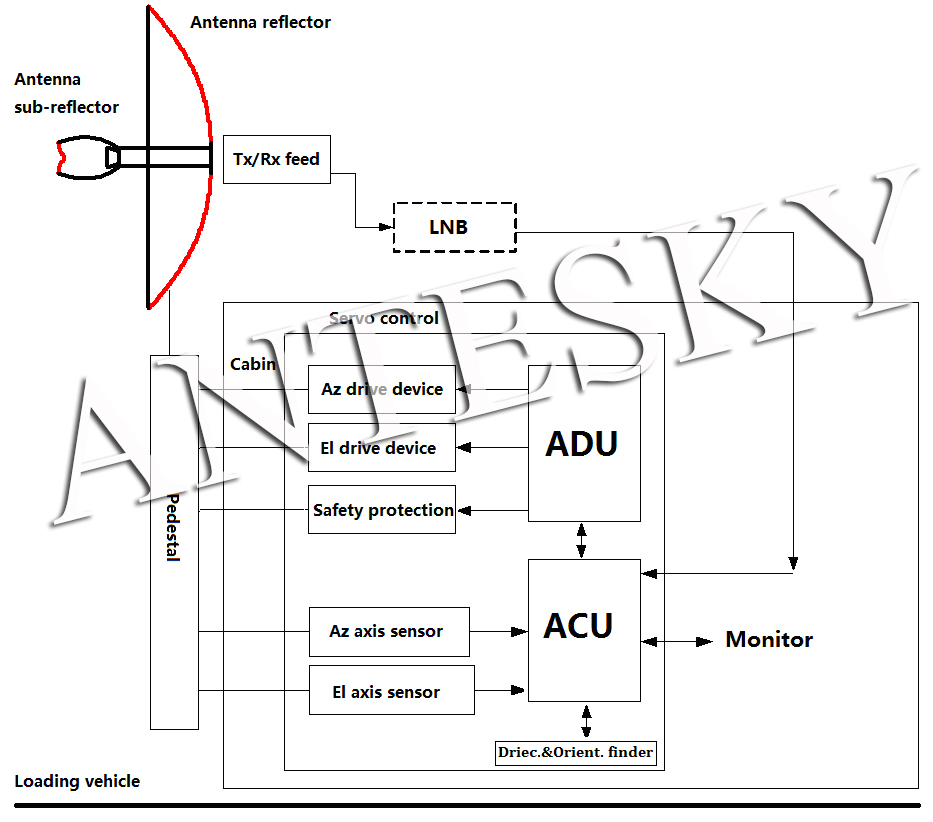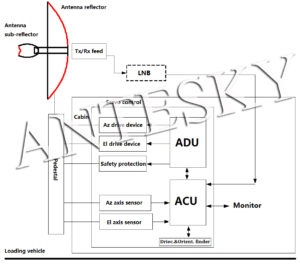
The Vehicle-Mount Mobile VSAT is a kind of satellite antenna installed in the car. The car satellite antenna receiving is the TV signal transmitted by the receiving satellite. As long as it is in the effective coverage area of the satellite signal, it can be effectively received. It is a truly seamless link, which is Mobile reception of satellite TV. Receiving satellite TV programs is a pleasure, and mobile satellite TV reception is the highest pursuit. The antennas in mobile reception are relatively “fixed”, which is relative to the receiving satellite and must be aligned at all times. Satellites can receive satellite TV signals.
The Vehicle-Mount Mobile VSAT can be used with the GPS locator and the RSSI signal strength analysis device to realize the function of the variable direction search signal in high-speed movement. The antenna has multiple built-in control motors. At the same time, you can watch more than 300 channels at home and abroad, and more TV programs on movie and TV channels. Another 2Mbps secure data communication, high-speed Internet access, VoIP communication, teleconferencing, WAN expansion, video broadcasting and other functions.
Diagram of Vehicle-Mount Mobile VSAT
- Feed sub-system: The antenna feeder subsystem is used for the transmission, reception and polarization identification of radio frequency signals. The subsystem includes a split carbon fiber reflective surface, a shaped feed, an OMT, a damper filter, and a support structure.
- Servo sub-system: The servo sub-system moves the azimuth and elevation of the antenna to the designated position according to the requirements of the control command, realizing the automatic satellite. The subsystem includes a controller, an azimuth motor driver, a elevation motor driver, an azimuth motor, a elevation motor, a speed reducer, an orientation sensor, a elevation sensor, an electronic compass, an inclinometer, and a corresponding transmission mechanism;
- Monitoring sub-system: The monitoring sub-system is used to monitor the real-time running status of the antenna and control the antenna to realize automatic tracking of the target satellite. The subsystem includes an ARM module, a WiFi module, an Ethernet module, an input module, and a display module;
- Power sub-system: The power sub-system is mainly for the whole system. The subsystem includes an AC-DC module, a DC-DC isolation module, and a control switch;
- RF subsystem: The RF subsystem is used to implement the up-conversion and amplification functions of the baseband signal, and the down-conversion and amplification process of the RF signal. The subsystem includes a power amplifier (BUC) and a low-noise amplifier (LNB).
Schematic of Vehicle-Mount Mobile VSAT
Precautions for Vehicle-Mount Mobile VSAT
Parking place selection
- Choose a flatand solid space as a parking lot. Ensure that the satellite signal transmission and reception, microwave signal transmission and reception does not form an occlusion.
- There should be no obstructions above the vehicle to prevent the antenna mast from rising normally.
- Try to avoid tall obstacles (steep slopes, tall buildings, tall trees, etc.) to ensure that the signal transmission and reception of satellite communication, microwave communication, and wireless bridge communication does not form an occlusion.
- If the utility power is used, the nearest effective power supply of the vehicle should be within 60M, and the ground pile can be grounded or connected to other grounding systems.
- Vehicle parking spaces should also consider the impact of vehicle noise on residents or the environment.
Mains power selection
The on-board system should consider the effective mains power supply at the destination site.
Before the on board system arrives at the site, it should consult with the unit or power supply department that provides the power supply.
Selection of transmission method
- The transmission mode to be adopted shall be negotiated with the relevant units, and the transmission mode shall be comprehensively considered in accordance with the principle of convenient access and the conditions of the parking place. If it is closer to the equipment room, it can be directly connected by fiber; otherwise, microwave or wireless bridge transmission mode can be adopted; in special cases, satellite transmission can be adopted.
- When using microwave or wireless bridge transmission mode, the position of the opposite end microwave erection should be pre-selected, and the nearest machine room and line-of-sight transmission should be considered comprehensively. In principle, before the on-board system reaches the target site, the opposite microwave antenna should be set up to minimize the time for system opening.
- When adopting the satellite transmission mode, the corresponding azimuth should be considered as no obstruction according to the longitude of the satellite used, and the vehicle head should be prevented from being parked toward the satellite orientation to facilitate the reception of the satellite antenna.
- The information that the car satellite system needs to obtain through automatic star: (1) GPS, (2) electronic compass, and (3) AGC (beacon voltage).
Determine BTS related data
- According to the network plan, determine the relevant data of the vehicle BTS, such as frequency point, neighboring area switching, etc. If necessary, test the data of the mobile network to the destination site to understand the frequency interference situation, traffic distribution, handover, and so on. At the same time, it confirms the access base station transmitted by the emergency vehicle with the transmission room, and checks the communication circuit at the base station side, checks the relationship of the cell corresponding to each emergency transmission circuit with the BSc, checks the number of devices defined by the cell, the device type and the software version, and the like. Ensure that the data definition of the BSC is fully compatible with the hardware installed in the emergency vehicle;
- Determine the coverage and direction of the base station antenna based on the network conditions at the site.
- According to the network plan, determine the relevant data of the BTS of the in-vehicle BTS system to access P to create a network.
Composition of Satellite system
According to system equipment configuration and modification requirements, small emergency communication vehicles include mobile communication systems (BTS and BSC equipment from different manufacturers), transmission systems (SDH, PDH, SOM wireless Ethernet bridge, vehicle satellite) and antenna feeder systems (satellite antenna, microwave) Antenna base station antenna, mast, etc.), wherein the satellite subsystem is mainly composed of the following devices: vehicle satellite antenna, GPS antenna, antenna control system, beacon receiver, Modem, LNB, solid state high power amplifier.
7.3m Vehicle-Mount Mobile VSAT and 5.4m car satellite antenna are still available in Antesky.
For more info, please contact sales@antesky.com
Further reading about Drive-Away Satellite Communication Antenna
4.5M C&KU Vehicle Mounted Carbon Fiber Deployable Kit Earth Terminal (DKET) Antenna
Composition and Application of Drive-Away Satellite Communication Antenna
Servo Control System for Quick-Deploy Trailer Mount Satellite Antenna
Satellite Monitoring system-4.5m Full-Motion Antenna Satellite Monitoring System








